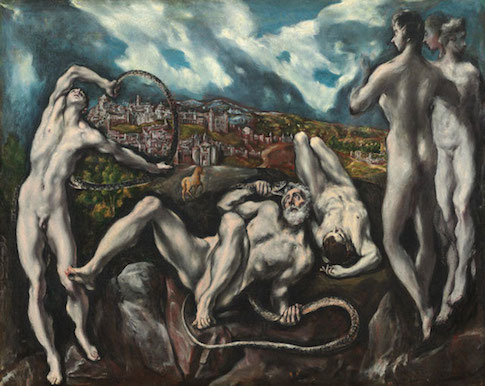Domenikos Theotokopoulos—known in death as El Greco—departed this earth by way of Toledo, Spain, four hundred years ago.
A virtuoso of Mannerism, the sixteenth century artistic trend that, in the standard telling, bucked the naturalist conventions of the High Renaissance to establish a style that was more about art, and less about the imitation of nature, El Greco’s reputation was largely subsumed by the neo-classical revivals of the 17th and 18th centuries. It was the late 19th century and the establishment of the permanent European avant-garde—and in particular the ascendancy of the Impressionists and later the Cubists, so widely beloved by museum-goers today—that provided for El Greco’s own rebirth.
In commemoration of his death, Washington’s National Gallery and New York’s Metropolitan Museum of Art and Frick Collection have mounted modest and lovely exhibits of whatever El Greco paintings they have on hand or could collect in a pinch from other museums. Both the Met and the National Gallery ritualistically inform the visitor of the affection for the man maintained by, for example, Cézanne and Picasso. This is noteworthy, of course, but it seems cheap and even a little bit scheming by way of an introduction.
What is interesting about El Greco is not how familiar he seems to modern museum-goers, insofar as his paintings seem to resemble those of the Impressionists and their heirs. What is interesting is how profoundly strange his work is when considered in light of what preceded it: That a man born only two decades after Leonardo’s death, and the peak of the scientific, intensely naturalistic and proto-secular humanism of the Renaissance, could make a career painting canvases like the View of Toledo:
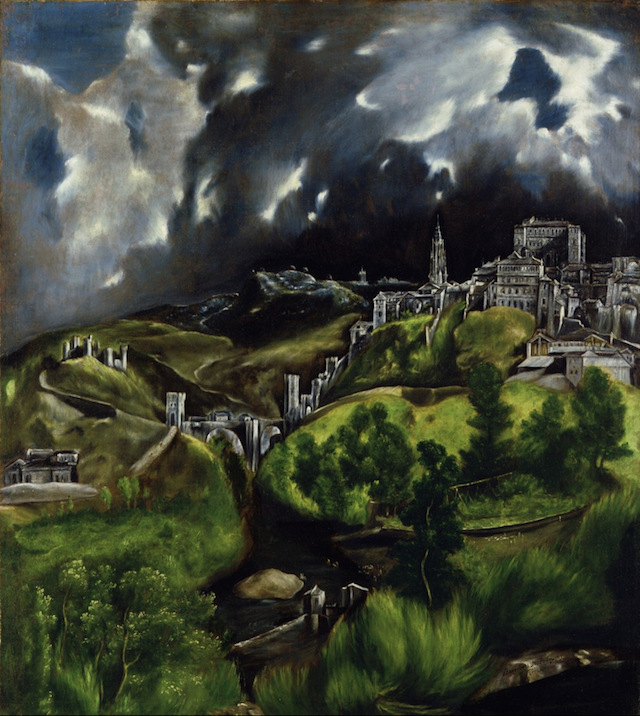
One of the pleasures of the commemorative exhibits is the opportunity to see El Greco’s paintings in context with one another, from early and not-entirely-successful efforts in Venice to imitate Titian’s style, to the increasingly confident works produced in Rome and finally in Spain. At times it seems like, even within single paintings, El Greco is working with the tools of three distinct styles of Mediterranean painting—Byzantine, Italian Renaissance, and Mannerism—and doing so simultaneously, containing multiple centuries of the history of art within his own singular person.
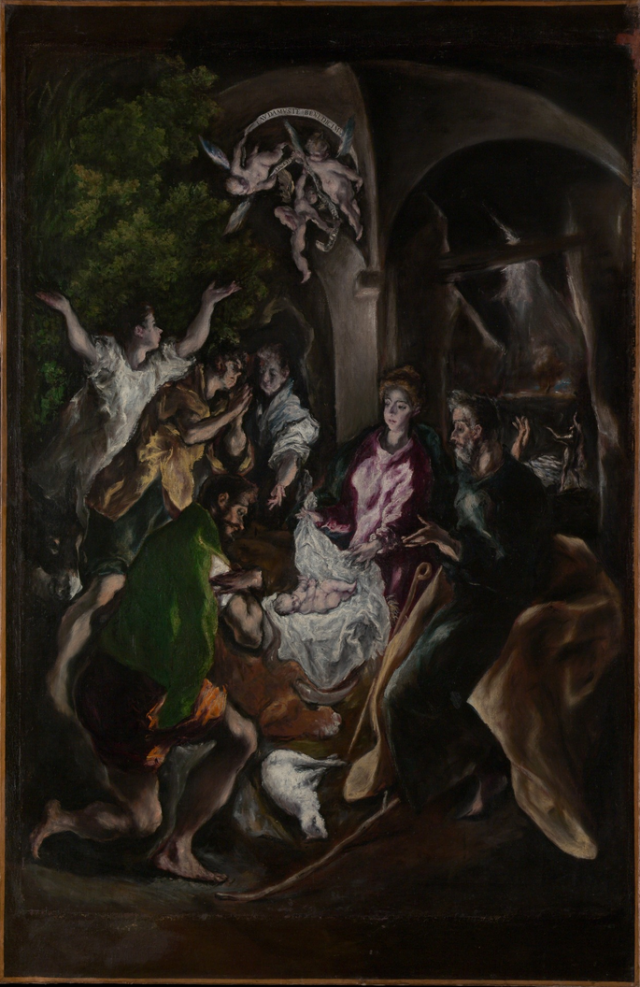
El Greco’s unconventional biography explains how this amalgamated style could come to be. Born in Crete in 1541, his early training was in the formulaic production of icons and devotional works in the Byzantine style. Surviving works from this period of his life are extremely rare—sadly, none were available for the three exhibitions here reviewed—but they show a mantic, restless quality that must have unsettled his teachers.
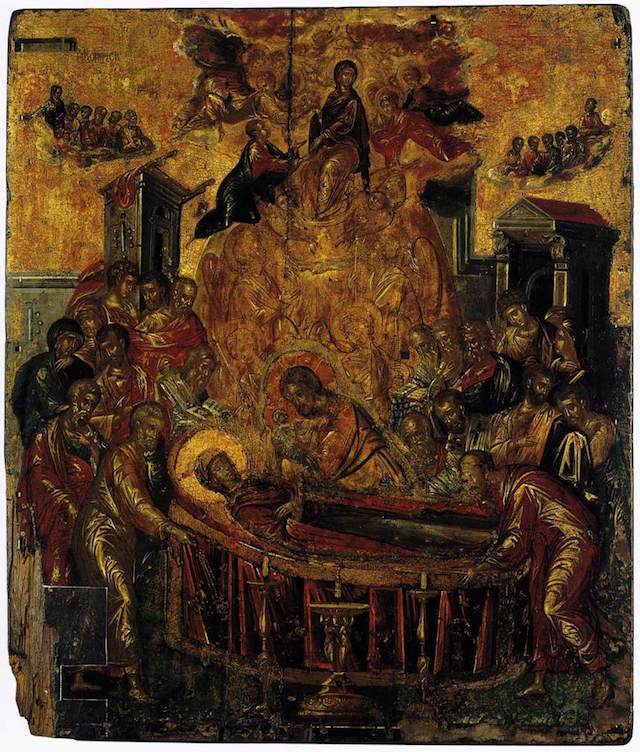
In his late twenties, he traveled to Crete’s political hegemon, Venice, to study and to paint. There he fell under the influence of the aging Titian, among others. From Titian he gained a knowledge of color, and an understanding of portraiture as a genre principally concerned with the revelation of character. A glance, at the Met, at the rich fabric of Cardinal Don Fernando Niño de Guevara’s robes, of his nervous sidelong glance, of the clenching left hand, could almost lead someone to think that they are looking at a Titian.
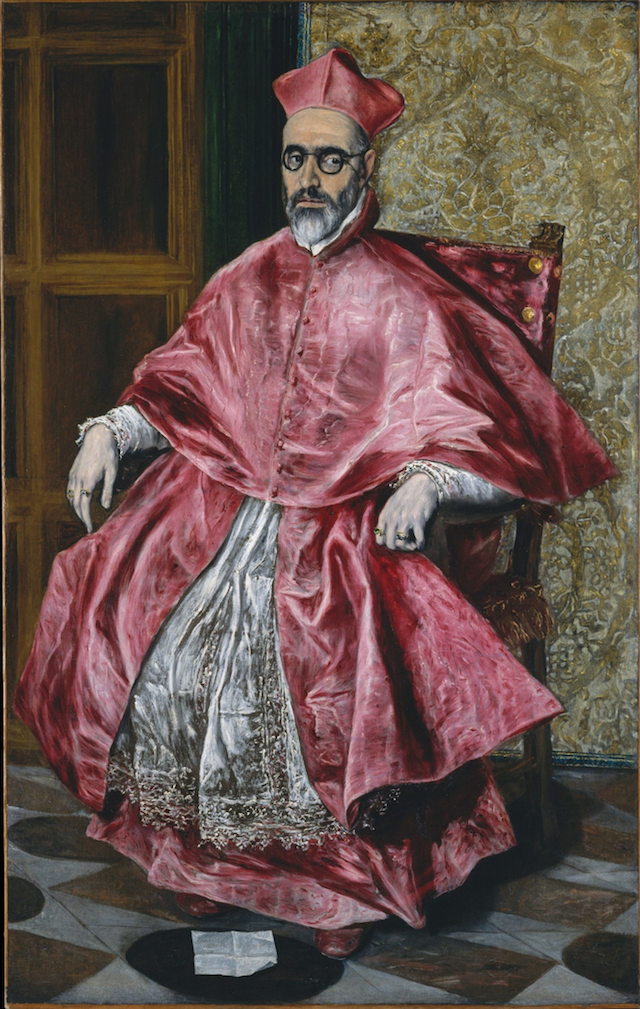
But then one notices the unrealistic length of the right index finger, the flat and somewhat careless construction of the space containing the Cardinal, and something pale and ethereal in his complexion and the fringes of his beard, and it is clear who painted the thing.
By the time El Greco knew Titian, the old master was shifting his style in response to the new mannerism introduced in Venice by Tintoretto and others. Perhaps as a response to the violent upheavals of the Reformation and the Counter Reformation, or perhaps simply as a consequence of the natural stylistic cycle of things, painters moved away from the scientific pursuit of verisimilitude, and toward making paintings that seemed to say: this is not nature, it is a painting—and look how well its creator can paint.
Critics initially imposed the label ‘mannerism’ on such an approach as a term of abuse. (Its original sense can be understood from Leonardo’s usage, when he wrote that artists should, "Never imitate the manner of another painter, or you will be called a grandson and not a son of nature in your art.") To be a mannerist was to be unoriginal, concerned with style for its own sake—to be, in a word, decadent.
The mannerists made a strong implicit case for themselves in response. To imitate fashionable formulae—elongated arms and necks, intentionally disordered spacial compositions—may be unnatural in the strict sense, but given that Leonardo, Raphael and the like had already perfected the art of verisimilitude, a sort of Harold Bloomian anxiety of influence prevailed: Where was the next generation to go? Moreover, perhaps there is an emotional or even spiritual dimension available only to those who were more interested in art-as-art than art-as-parlor-game-imitation.
After Venice, El Greco spent a few years in Rome, living with Cardinal Alessandro Farnese, grandson of the Pope, before being ejected under obscure circumstances. After that he continued his westward progress to Milan, where he tried and failed to find traction with the court of Philip II. Eventually he went to Toledo—a provincial spot in the aftermath of Philip’s removal of the capital to Madrid in 1561—and remained there for the second half of his life, flourishing.
It is true that El Greco was a prime exemplar of Mannerism, and also true that to consider him as a ‘Mannerist’ is to risk missing how entirely unique he was. His youthful immersion in formulaic Byzantine devotional painting gave his mature work an organic connection to a naïve style that the Italians had been moving steadily away from since the early 14th century. Rubbing shoulders with Titian at precisely the moment the High Renaissance gave way to Mannerism, followed by traveling to counter-reformation Spain: these ingredients combined to make a man who could communicate the raw, unironic spirituality of medieval Byzantium to an audience of the Spanish gentry, with the skill of an Italian humanist possessed of a sophisticated technical arsenal three centuries in the making.
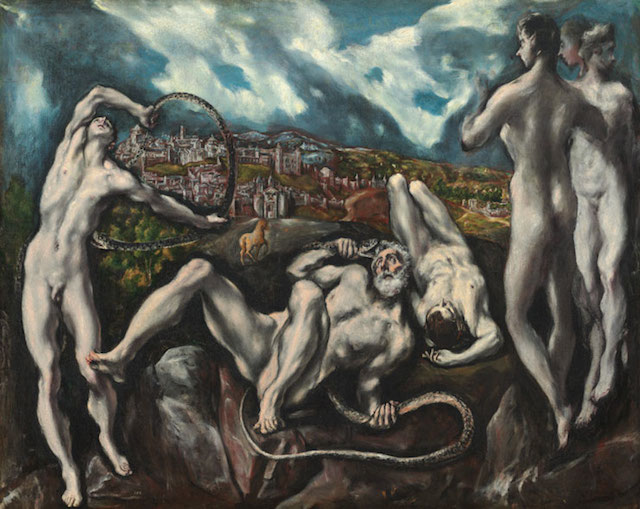
To see in isolation the various elements displayed in synthesis within the gallery devoted to El Greco at, for example, the National Gallery, would generally involve walking through the entire northwest corner of the building, beginning with first stirrings away from naïve formulae in Duccio and Giotto to the peak of verisimilitude in Raphael’s Alba Madonna, and finally to the displayed self-consciousness of art-as-art in Tintoretto and late Titian.
Wandering such a route gives one a sense of cycles at work. The same progression of naïve to realist to self-conscious stylishness can be seen in Greek sculpture’s movement from the archaic, to the ‘classical’ naturalism of Phidias, and finally to the sensuous Hellenism which succeeded it. The late stage of such a cycle can be seen in contemporary American art. Radical creativity, the fetish for making something entirely new, has become the reigning mannerism. Artists are so busy making sure that they are Originals that they all end up imitating each other in this respect. Many fail even at this, and simply perform wan imitations of the meaningless innovations of others. (Found art, anyone?)
The current retrospectives on El Greco give their visitors a chance to see a genius at work on the decadent end of a cycle, using the stylistic license of his age to bring to bear an electric religiosity in the creation of something not only new and unique—empty virtues, in isolation—but beautiful.
